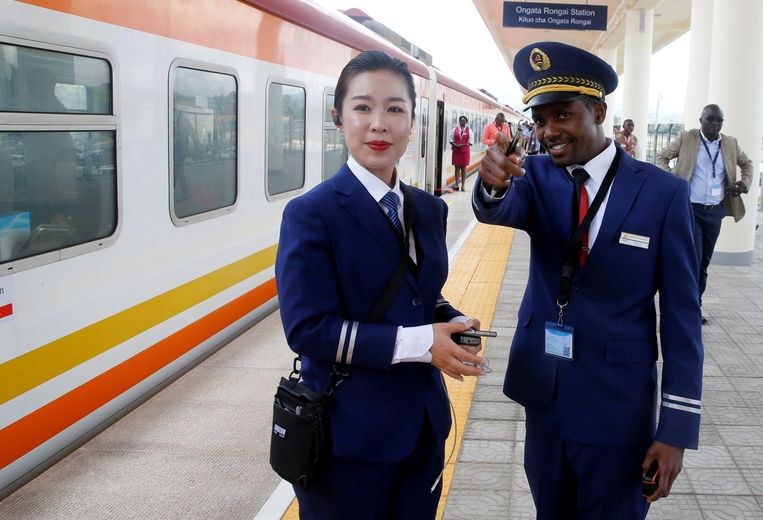China is lending unimaginably huge sums to developing economies. In Africa, it has already surpassed the United States as the largest lender. Now that countries are stuck in the payment, problems arise: No one knows exactly how much was borrowed from China.
With upbeat tweets, Zambia’s new president, Hakainde Hichilema aka Bally, is trying to restore the confidence of international investors in his faltering economy. “The creditors do not need to worry about our current financial situation. (…) You will pay Bali.”
The problem is that Bally doesn’t know how much to pay and what. Next to the empty cupboard, ancestor Edgar Longo A mountain of debt mainly on China. When Hechilema took office in August, Zambia suffered a massive rise in inflation and unemployment.
Before the end of the year, Hichilema Help over that mountain of debt Settlement with the International Monetary Fund (IMF), but debt inventory takes weeks. At the end of September, research by the China and Africa Research Initiative (CARI) of the US Johns Hopkins University presented a solution: According to CARI, the $3.4 billion that China owes from the Zambian government according to Lungu is almost double.
With this $6.6 billion debt to China – 43 percent of GNP – Zambia is an extreme case. On average, African countries owe 10 percent of their GDP to China. With Beijing accounting for 20 percent of all loans to African countries, similar ambiguities surrounding debt to China play out across the African continent.
In early October, AidData, a data research lab at the College of William and Mary in Virginia, released a detailed analysis of China’s cash flows. It took at least four years of research into more than 13,400 China-paid infrastructure projects in 165 countries over 18 years to prove that Chinese state-owned banks lent far more than previously thought. AidData comes in at $843 billion worldwide. Part of that is the unknown world of hidden Chinese loans worth $385 billion. The research sheds new light on the myths about China’s foreign loan policy.
Myth 1: Chinese loans only serve unprofitable prestige projects
In state-to-state loans, China’s Ministry of Commerce fulfills African politicians’ wildest dreams. Through interest-free loans, China is financing and constructing sports stadiums, convention centers and other prestige-enhancing projects.
China’s state-owned commercial banks and sovereign wealth funds, which now account for 70 percent of China’s foreign loans, prefer to focus on economic hardware. African countries that want to industrialize them train linesroads and factory sites, but the funds for this great leap forward are not available.
China, on the other hand, has a lot of cash on hand due to its trade surpluses with almost every country in the world. Beijing has so far invested those foreign reserves in US government bonds, but that became very dangerous for China after the 2008 financial crisis.
An alternative destination for that money is the Belt and Road Initiative (BRI), which was launched in 2013. Through Chinese loans, Beijing provides countries with infrastructure, telecommunications, residential areas, and industrial buildings built by Chinese workers with Chinese machinery, who work abroad to eliminate energy The surplus of steel and concrete industry in China. The Belt and Road Initiative has been presented as a gift to the world, and it primarily serves Chinese self-interest.
Myth 2: Borrowing from China is expensive
Not at first. The contracts studied by AidData contain market-based interest rates. Local Chinese bankers are used to financing large, high-risk projects. Loans are the cork on which the Chinese economy is floating: if something goes wrong, the bank won’t pull the short straw. Non-performing loans are covered by new loans, as an army of new lenders turn a profit.
President Xi Jinping said Beijing is offering this growth model, driven by easy and risky loans, as “a new option for other countries that want to speed up their economic development without compromising their independence.” Where Western bankers impose conditions on human rights, creditworthiness, and sustainability, Chinese financiers are more flexible.
Chinese loans become significantly more expensive in the event of default. In 2016, for example, the Democratic Republic of the Congo defaulted on a $1.3 billion repayment to China’s Eximbank. He deferred repayment for 15 years at 1.5 percent interest, until the debt rose to $1.6 billion. Eximbank made additional money by requiring immediate repayment of another $300 million of debt as a condition of the delay.
Myth 3: Chinese loan structures are not transparent
This put it mildly. The contracts revealed by AidData are riddled with confidentiality clauses. The lack of central coordination in Beijing is contributing to the murky chaos in loans for the proliferation of Belt and Road projects.
Before the Belt and Road Initiative, foreign borrowing was the prerogative of the central government, and today state-owned banks, state-owned enterprises, joint ventures and public-private investment structures dominate. The Chinese government has unleashed this on countries so weak that they can no longer borrow. For this, Chinese bankers have innovative financial solutions that do not appear in the accounts of the borrowing government, while they directly or indirectly pay for repayment: the so-called hidden debt.

The main drawback of hidden debt: hardly anyone knows who borrowed what and under what (secret) circumstances. As a result, economists, governments, international lenders and financial regulators are left groping in the dark amid shaky houses of hidden debt cards. Zambia is no exception to the undervaluation of debt owed to Beijing: according to AidData, governments do not disclose an average of 5.8 percent of the GDP of their debt to China.
AidData comprises 38 predominantly African countries that have debts to the Chinese government worth more than 10 percent of their economies. Ten other countries have hidden debts to Chinese banks amounting to more than 10 per cent of their GDP. countries like LaosAngola, Mozambique and now Zambia are at risk of succumbing to a combination of sovereign debt and hidden loans. Either way, the money will have to be paid back one day.
Myth 4: Chinese loans cause countries to lose their strategic assets
Western politicians see evil intent: China deliberately lures poor countries into a debt trap, to bypass this debt trap diplomacy (Debt Trap Diplomacy) To master strategic assets, such as ports and mineral resources. It will take china as payment in kind. With this alarming, Washington is trying to get states involved in the Build Back Better World (B3W) initiative, a belated US competition effort with the BRI.
The myth of Chinese financiers lurking as predators on other people’s raw materials and infrastructure needs to be accurate, because AidData has found only one case where a project offered by China acts as collateral: if Sierra Leone does not repay the fruits of its port, the cranes and other machines go to the creditor. However, Chinese bankers are not enthusiastic about owning remote copper mines, railways or other assets. They want to make a profit from their borrowed money. That’s why in Zambia a hydropower plant, two airports and a TV channel are operated by Chinese companies or joint ventures, which transfer part or all of the income to Chinese banks.
Chinese bankers prefer to have collateral in the form of offshore bank accounts, which only the Chinese creditor can access. Governments that have debts deposit their income there, for example from the oil or mining industry. In case of non-payment, the Chinese party does not have to confiscate such a bank account, but drains such a bank account without difficult procedures. This explains why Chinese creditors are given precedence over other creditors: if they don’t pay on time, they pay themselves.
Chinese bankers hate debt forgiveness with other foreign lenders, and they’re all at a loss. AidData found that at least 75 percent of Chinese contracts prohibit debt restructuring in a multilateral context (eg via the IMF).
When dealing with debt, Chinese bankers prefer not to do so with others. Therefore, with eighteen different Chinese lenders competing with each other, it will be difficult for Zambia to reach joint debt relief agreements. The IMF will only consider helping Zambia’s debt, totaling about $27 billion, after Hechilema has worked its way out of China’s debt quagmire.
Myth 5: Through loans, China bends the political system of other countries
Direct interference in the politics of others runs counter to Chinese foreign policy. China prefers dependency cultivation, which is used to serve Chinese national interests.
Indeed, there are signs that China is becoming more cautious about borrowing, because it is not in Beijing’s interest to destroy African economies with debt. On the contrary, it should thrive as new sales markets. It is predicted that in fifteen years, 800 million Africans will have middle-class incomes: these are potential customers of Chinese companies.
According to geoscientist Nadège Rolland, associated with the US National Bureau of Asian Research, there is indeed a geopolitical strategy behind the Chinese loans. China aims for hegemony in the “global south”, southern countries that do not belong to the existing system of rich industrial countries. The African continent is the strategic focal point of Beijing in its rivalry with the United States. There, Beijing can defeat the West, without entering into a direct confrontation.
China overtook the United States in 2009 as Africa’s largest trading partner, and in 2014 as Africa’s largest lender. China now invests twice as much money as the United States in developing economies, also with the aim of Africa and the rest of the South realizing that democratization according to the Western model is not a prerequisite for economic growth. But they are merely alerts rather than direct political intervention, such as Chinese leadership courses for African talent, or funding for high-tech security systems that authoritarian governments can also use for political ends. If countries do not like the Chinese model, Beijing does not insist that governments not irritate. Making money remains more important at the moment.

“Creator. Award-winning problem solver. Music evangelist. Incurable introvert.”







More Stories
British military spy satellite launched – Business AM
Alarming decline in the Caspian Sea
Lithuania begins construction of military base for German forces